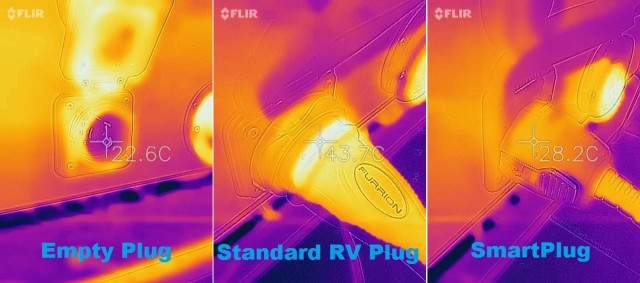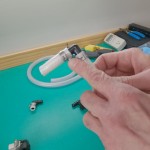This post may contain affiliate links.
A few years ago while visiting our friends at Advanced-RV, we learned about a new type of shore power connection they were putting on their rigs, The SmartPlug. (We like visiting Advanced-RV because they’re always pushing the envelope with cool new stuff.) The SmartPlug had a few unique features, like easy locking and weather proofing, but what really captured my interest was the claim of reduced connection temperatures and improved safety through increased contact area.
Ever since then, I had been wanting to get a SmartPlug on our own rig. I finally did, and decided to put the “safer connection” claims to the test. The result is this video:
Here’s the deal. On their website, SmartPlug includes an infrared photo that plainly shows the SmartPlug operating at a cooler temperature than a “regular” 30 amp connection. But I had questions about this. Was the load going through the two plugs the same? Were both plugs installed properly? And most importantly, was the regular 30 amp connection plugged in securely and correctly? Basically, I wanted to know if the SmartPlug marketing department had rigged the test and used a “faulty” connection as its comparison.
The Test
The setup for this test was pretty straight forward. First, I took an infrared reading of the empty and un-used plug. Then, I simply plugged in the regular connection – making sure to do it properly and make full contact. After that I ran a load of 24 amps (at 120 volts) through the connection for one hour. At the end of the hour, I duplicated the SmartPlug infrared photography and took a temperature.
Then, it was time to install the SmartPlug. I made sure to follow the manufacturer’s instructions on the install. SmartPlug even provides torque specifications for all of its electrical connections, and you’ll see my small torque wrench in the video. Once I had both the socket and plug parts of the SmartPlug installed, I repeated the 24-amps-for-one-hour test, and took another infrared video.
The Results

While I couldn’t control for outside temperatures, I did run the test on a cloudy day, and out of direct sunlight. The temperatures I recorded were:
- Empty Connection: 22 degrees Celsius / ~72 degrees Fahrenheit
- Standard RV Connection: 43 degrees Celsius / ~109 degrees Fahrenheit
- SmartPlug Connection: 28 degrees Celsius / ~82 degrees Fahrenheit
So good news! The SmartPlug did indeed result in cooler connection temperatures. At least in this test.
Now, I do want to point out that I DON’T think my regular RV connection was faulty, or in any way unsafe. The temperature of the plug was not dangerous or painful to touch at all, and there was no danger to our rig throughout the test. But… I knew that my shore power connection was installed properly and with tight contacts. It’s not too hard to find pictures of burned and blackened shore power connections online. If you had a compromised shore power connection, the temperature could easily get to an unsafe level.
There are other features of the SmartPlug that, while I didn’t test, I do like. The plug has locking tabs on each side that are far easier to use than the threaded connection on my old plug – and they simply can’t be cross-threaded. The SmartPlug also has weather-proofing in several areas that should provide increased confidence in wet environments. (They also market marine connections, so this makes perfect sense.)
All in all – I can recommend the SmartPlug. It does seem to provide – at least based on my test – an increased level of safety against connection overheating for your RV shore power. I’m certainly keeping ours.
Now, if I could just do something about the pedestal end of the connection…











Did you test a new smart plug against a used twist lock?
We only ran the tests you see here. I imagine (but can’t prove) that a used twist lock would fare worse.
I normally think in terms of “delta T”. So temperature rise over ambient was 37f and 10f respectively. So……on a 92f day the twist plug would be 92+37 = 129f and the Smart Plug 92+10 = 102f. Twist plug would be getting quite warm…maybe hot… Yes you can un-plug it maybe using a rag. My concern though would be the materials it is made out of. When I get extension cords loaded the hot spot is the plugs and that plastic starts getting very soft. That makes me nervous. Also I personally have a hard time getting that twist lock ring on correctly. I do many time say “prayers” over it but it still cross-threads. Thank you for your A-B testing. Enjoy all you RV videos.
Might be a stupid question, but will this fit over the traditional round rv plug outlet? I would like to convert mine.
Doesn’t fit over it. It’s a replacement.
Hi James and thanks for all the great video content! Just looking over my soon to purchase RV specs now and do you still recommend the 525 amp lithium battery from the folks in Florida? I am ready to pull the trigger and order it along with the inverter that you recommended about one year ago. Please let me know your thoughts even if they have not changed.
We still love our Lithionics battery! And we’ve upgraded it. Generally speaking, I would say to get the biggest battery you can fit in your space and budget.
Our feelings on this haven’t changed!
Thank you for a great evaluation of our SmartPlug product. I appreciate your time and all of the effort to make your video. I would like to provide you with some additional information about the thermal image we use in our marketing and the testing criteria. Please send me an email and I will send you the info.
Thanks!
Terry
Hi Terry – I’ll send you an email. I’m curious if I missed anything in my test. Thanks for chiming in!
It looks like a great item. The biggest issue I’ve seen is the worn, dirty, corroded receptacle on the campground pedestal, tho. Any suggestions for improving that end of my RV’s “shore power” cord?
I know!
I’ve been thinking of what to do about the other end of the cord, and I just can’t come up with anything. You get what you get, I suppose.
I like the concept and the design but I’m not sure if there is enough gain to make it worth while. They are rather expensive ($140 for the set) and an additional $70 if you need to make an adapter (which I do).
It can get a little spendy; can’t deny that. Might not be for everyone.
If I had to replace a connection and plug anyway, I would probably replace with a SmartPlug.
Also, if I had concerns about the connection quality, or I was trying to run a welder through my RV or something… 😉
This isn’t about the Smart Plug but about something in the video. I saw you’ve installed a faring on the roof rack on Lance. Have you ever provided instruction as to how you built that?
I installed the fairing a couple years back. Search our site for “fairing”, and you’ll get this post:
Building a Roof Rack Mounted Wind Fairing for the Travato
Does the smart plug have adapters for standard plug interfaces? I would not want to be limited to only the smart plug configuration, if you find yourself without the cord with the smart plug connector, you are out of luck?
I’ve never seen any adapters, and I don’t think SmartPlug makes any. That would sort of defeat the purpose of getting rid of the regular RV-style connection. We always travel with our own shore power cord, so we don’t anticipate it will be a problem.
I suppose if you were in a situation where you have to “borrow” a cord, you might run in to difficulty. That’s never happened to us. We have needed an extension cord a time or two. That would still work, as the pedestal end of the cord is the same.
My question is simple. What was Steph’s reaction to seeing the video and what you did to her stove?
Have a question about the temperature measurement.
It *looks like* the SmartPlug cord end has an additional (weatherproofing?) shroud around the plug that a 30A Hubble twistlock doesn’t have. That plug just appears to be the barrel that’s inserted into the bulkhead socket.
If so, could that shroud keep heat buildup away from the outside of the SmartPlug assembly, causing it read a lower external temperature than is actually seen at the power pins contacts…as compared to the twistlock style?
I’d assume that in either properly functioning plug, heat buildup is largely conducted away by the wire.
The SmartPlug does seem to have more plastic around the contact area, and I agree that this could help shield the camera from seeing any heating, if it occurred.
That’s why I let the test go for an hour. Even if there was additional material, I surmised everything would have heated through and reached equilibrium with the atmosphere after an hour.
Measuring temperature at the contacts themselves would have been ideal. But… I was paying for this myself. 😉
I wonder what the “empty plug” tempatures before and after each test were?
I didn’t take the temp of the empty socket after each run. That would have been difficult, as I don’t always nail everything on the first take. To be fair, I would have had to take the video immediately after removing the plug in both cases. C’est la vie.
“Before” empty socket temperatures were basically ambient. The SmartPlug socket was installed in the van a good hour or so before I got the plug finished and was able to run the test.
I’m very familiar with this in the boating world. The secure fitment at the RV is what it is mostly promoted. Boats catch fire frequently from the poor prong fit into the sockets in traditional round connections. Arcing occurs from the loose fit and fires start. So this Smart Plug is a very nice product. I have a round version that attempted to copy some of the Smart Plugs connector benefits but it still isn’t as good as the Smart Plug.
Never thought about trying to develop one myself!
Great video. Your findings matched my suspicions that the SmartPlug is an improvement but probably not an essential upgrade for most people.